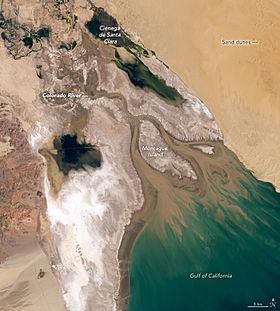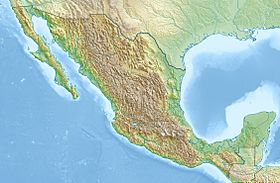Colorado River Delta facts for kids
Quick facts for kids Colorado River Delta |
|
|---|---|

Satellite view of the Colorado River Delta featuring Isla Montague and the Ciénega de Santa Clara wetland
|
|
| Location | Baja California and Sonora, Mexico |
| Coordinates | 31°44′N 114°40′W / 31.74°N 114.66°W |
| Part of | Colorado River |
| Offshore water bodies | Gulf of California |
| Area | 7,810 hectares (19,300 acres) (historical) |
|
Designations
|
|
| Official name: Humedales del Delta del Río Colorado | |
| Designated: | 20 March 1996 |
|---|---|
| Reference #: | 814 |
The Colorado River Delta is a special place where the Colorado River meets the Gulf of California (also called the Sea of Cortez). It's located in northwestern Mexico, mainly in the states of Baja California and Sonora. This area is part of a larger geological region known as the Salton Trough.
Long ago, the river's flow and the ocean's tides worked together to create a lively environment. It was home to many different kinds of plants and animals. These included those that live in fresh water, slightly salty water (brackish), and full saltwater. The river used to split into many small channels, forming a complex area of estuaries and land ecosystems.
However, over time, people started using a lot of water from the river further upstream. This meant less fresh water reached the delta. Because of this, most of the natural wetlands in the area have disappeared. The water ecosystems have also changed a lot. Luckily, there's a plan now to bring the wetlands back to life. This plan involves releasing a special "pulse" of water down the river to help the delta heal.
Contents
A Look Back: The Delta's Natural History
Until the early 1900s, the Colorado River flowed freely. It started high up in the Rocky Mountains and traveled all the way to Mexico. There, it emptied into the Gulf of California. The river carried huge amounts of rich silt (fine dirt) from its journey. This silt helped create the massive Colorado River Delta.
Before big dams were built, the Colorado River fed one of the largest desert estuaries in the world. This huge area at the northern end of the Gulf of California was once covered by about 7,810 square kilometers (about 3,015 square miles) of wetlands. These wetlands included areas with riverbanks, fresh water, brackish water, and tidal zones. They supported a huge variety of plants, birds, and other animals.
Because most of the river's water reached the delta back then, it brought fresh water, silt, and nutrients. This created a complex system of estuarial wetlands. These wetlands were perfect places for birds to feed and build nests. They also served as spawning grounds for fish and marine mammals. Compared to the dry Sonoran Desert around it, the Colorado River Delta was incredibly full of life.
People and the Delta: A History
Early Life in the Delta
Early explorers who visited the delta saw many animals. They reported jaguars, beavers, deer, and coyotes. There were also lots of waterfowl, fish, and other creatures living in the water and estuaries.
Explorers also met the local people called the Cucapá. These people are descendants of the Yuman-speaking Indigenous peoples. They have lived in the delta for almost a thousand years. The Spanish explorer Hernando de Alarcón was the first to write about meeting the Cucapá in 1540. He said he saw many thousands of them. The Cucapá used the delta's floodplain for farming. They grew maize (corn), beans, and squash. They also harvested a wild grain called Palmer's saltgrass, which grows in salty soil.
On the map the Delta was bisected by the river, but in fact the river was nowhere and everywhere, for he could not decide which of a hundred green lagoons offered the most pleasant and least speedy path to the Gulf.
—Aldo Leopold, from A Sand County Almanac, describing the Colorado River Delta as it existed in 1922
How Dams Changed the Delta
Today, the delta is very different. Like other river deltas in deserts, such as the Nile Delta, the Colorado River Delta has been greatly changed by human activities. For many decades, people built dams and moved water away from the river in the United States and Mexico. This has left the delta with only small wetlands and salty mudflats.
When large reservoirs behind the dams filled up, they captured the river's floodwaters. This meant fresh water could no longer reach the delta. The building of Hoover Dam in the 1930s was a big turning point. For six years, while Lake Mead filled, almost no fresh water reached the delta. Even spring floods were stopped. The same thing happened from 1963 to 1981 when Lake Powell filled behind the Glen Canyon Dam.
Now that these reservoirs are full, the dams control the river's flow. This helps make sure water is available for cities and agriculture in the Western United States. Floodwaters are only released if the dams can't hold any more.
Because of the lack of fresh water, the delta's wetlands have shrunk to only about 5% of their original size. Also, plants that are not native to the area have taken over. These invasive plants have out-competed the native species. Forests of native cottonwood and willow trees have been replaced by sand and mudflats. These areas are now mostly covered by non-native plants like tamarisk (salt cedar), arrow-weed, and iodine bush. This change has made the area much less suitable for native wildlife.
When Floods Returned in the 1980s
In the 1980s and early 1990s, the reservoirs were full, and there were several big floods. These floods caused water to be released, and it reached the delta. These flows helped bring back the active floodplain. They also helped new plants grow in many areas and brought back some of the riverbank forests.
Wildlife in the Delta
The delta is home to many different kinds of wildlife. This includes several species that are threatened or endangered. Mexico's environmental rules list these endangered species found in the delta:
- The desert pupfish: The largest group of these fish lives in the Ciénega de Santa Clara.
- The Yuma rail: This bird is also endangered.
- The bobcat: A wild cat found in the area.
- The vaquita porpoise: This is the smallest marine cetacean (like a dolphin or whale) in the world. There are thought to be only about 12 vaquitas left.
- The totoaba: This large, steel-blue fish can grow up to 2 meters (7 feet) long and weigh 136 kilograms (300 pounds). It used to be fished for food, but it is now almost extinct.
- The Colorado delta clam: This clam used to be very common and was an important part of the delta's food chain.
The delta is also very important for migratory birds. It is the main freshwater marsh in the region. A total of 358 bird species have been seen in the Colorado River Delta and the upper Gulf of California. Some of these are endangered or threatened in Mexico. Some birds that used to live or breed here, like the southwestern willow flycatcher, the Fulvous whistling duck, and the sandhill crane, are no longer found in the area.
The Delta as a Biosphere Reserve
The Gulf of California is part of Mexico, specifically the states of Baja California and Sonora. In 1974, the Mexican government set aside parts of the upper Gulf and lower Colorado River Delta as a protected zone.
In June 1993, the United Nations Educational, Scientific and Cultural Organisation (UNESCO) named over 12,000 square kilometers (about 4,633 square miles) of the Gulf of California and Colorado River Delta as a Biosphere Reserve. Within this large area, more than 4,000 square kilometers (about 1,544 square miles) closest to the Colorado River Delta are called the "core area." This is the most protected part. The remaining 8,000 square kilometers (about 3,088 square miles) of open water and shoreline are a "buffer area."
UNESCO only considers areas for Biosphere Reserve status if the country where the site is located suggests it. Once an area is named a Biosphere Reserve, it still belongs to and is managed by that country. In Mexico, government agencies like the National Commission of Protected Natural Areas (CONANP) and the Secretary of the Environment, Natural Resources and Fisheries (SEMARNAP) manage the Biosphere Reserve.
Besides being a Biosphere Reserve, about 2,500 square kilometers (about 965 square miles) within the Colorado River Delta are also a Ramsar Wetland. This means it's a wetland of international importance for its plants, animals, water, or other features. The U.N. gives this title after the country nominates the site.
Images for kids
See also
 In Spanish: Delta del río Colorado para niños
In Spanish: Delta del río Colorado para niños




